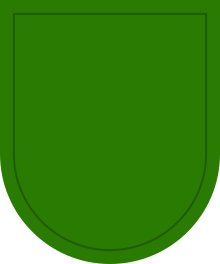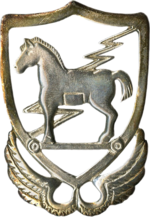
The United States Army Special Forces (SF), colloquially known as the "Green Berets" due to their distinctive service headgear, is the special operations branch of the United States Army. Although technically an Army branch, the Special Forces operates similarly to a functional area (FA), in that individuals may not join its ranks until having served in another Army branch.

The 75th Ranger Regiment, also known as Army Rangers, is the premier light infantry unit of the United States Army. The 75th is also part of the United States Army Special Operations Command and the Department of Defense Joint Special Operations Command. The regiment is headquartered at Fort Moore, Georgia and is composed of a regimental headquarters company, a military intelligence battalion, a special troops battalion, and three Ranger battalions.
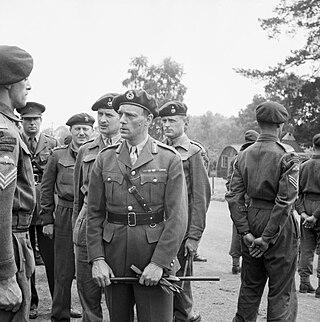
The green beret was the official headdress of the British Commandos, a special-forces unit active during World War II. It is still worn by members of the Royal Marines after passing the Commando Course, and personnel from other units of the Royal Navy, Army and RAF who serve within 3 Commando Brigade and who have passed the All Arms Commando Course.

The Air Assault Badge is awarded by the U.S. Army for successful completion of the Air Assault School. The course includes three phases of instruction involving U.S. Army rotary wing aircraft: combat air assault operations; rigging and slingloading operations; and rappelling from a helicopter.
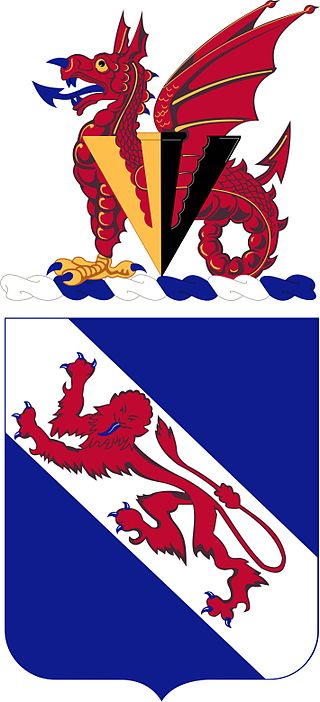
The 508th Infantry Regiment is an airborne infantry regiment of the United States Army, first formed in October 1942 during World War II. The 508th is a parent regiment under the U.S. Army Regimental System, and two battalions from the regiment are currently active: the 1st Battalion, 508th Parachute Infantry Regiment is assigned to the 3rd Brigade Combat Team, 82nd Airborne Division, and the 2nd Battalion, 508th Parachute Infantry Regiment is assigned to the 2nd Brigade Combat Team, 82nd Airborne Division. The regiment served in combat during World War II, and regimental elements have served in combat in the Dominican Republic, Vietnam, Grenada, Panama, Iraq and Afghanistan.
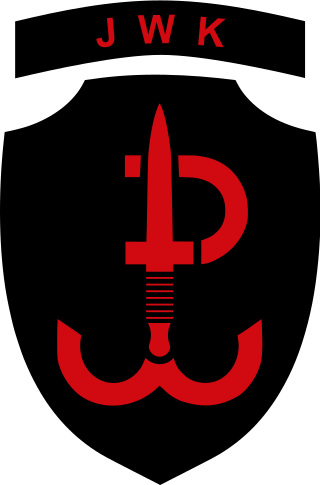
The Jednostka Wojskowa Komandosów, commonly called JWK and formerly known as 1 Pułk Specjalny Komandosów, is one of six special forces units currently operating within Poland's Centrum Operacji Specjalnych - Dowództwo Komponentu Wojsk Specjalnych. JWK was formed in 1961 and is the oldest still active Polish special operations unit. The unit is located in Lubliniec, Poland.

The 325th Infantry Regiment is an infantry regiment of the 82nd Airborne Division. The regiment serves as the 82nd Airborne's light infantry parachute insertion fighting force of the United States Army, with a long and distinguished history, having taken part in World War I, World War II, the Vietnam War, the invasions of Grenada and Panama, as well as the Gulf and Iraq Wars. The subordinate units of the regiment constitute the bulk of the infantry elements assigned to the 2nd Infantry Brigade Combat Team, 82nd Airborne Division.
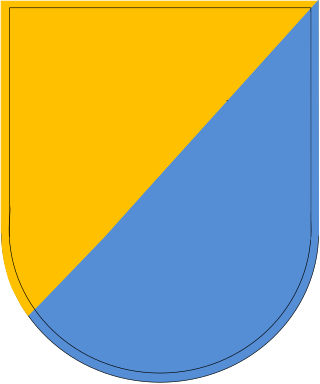
The 8th Special Forces Group of the United States Army was established in 1963 at Fort Gulick, Panama Canal Zone. The primary mission of the 8th Special Forces Group (Airborne) [(SFG ] was counter-insurgency training for the armies of Latin America. Some training was performed under the sponsorship of the School of the Americas, also located at Fort Gulick.
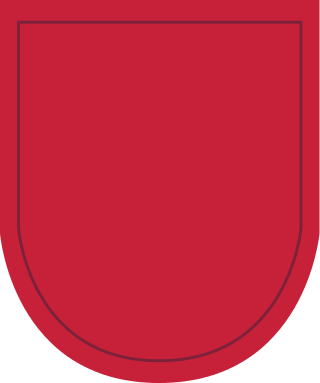
The 7th Special Forces Group (Airborne) (7th SFG) (A) is an operational unit of the United States Army Special Forces activated on 20 May 1960. It was reorganized from the 77th Special Forces Group, which was also stationed at Fort Liberty, North Carolina. 7th Group—as it is sometimes called—is designed to deploy and execute nine doctrinal missions: unconventional warfare, foreign internal defense, direct action, counter-insurgency, special reconnaissance, counter-terrorism, information operations, counterproliferation of weapons of mass destruction, and security force assistance. The 7th SFG(A) spends much of its time conducting foreign internal defense, counter-drug, and training missions of friendly governments' armed forces in South, Central, and North America as well as the Caribbean. 7th SFG(A) participated in Operation Urgent Fury in Grenada in 1983, and in Operation Just Cause in Panama in 1989. The 7th SFG(A) has, like all the SFGs, been heavily deployed to Iraq and Afghanistan in the War on Terror. The 7th SFG has lost more SF soldiers in the Global War on Terrorism than any other SFG.
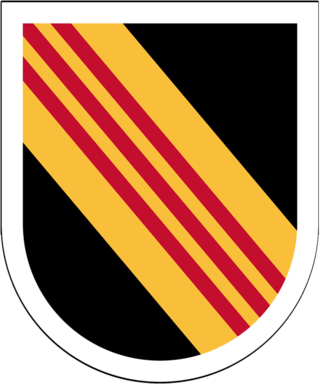
The 5th Special Forces Group (Airborne) (5th SFG (A), 5th Group) is one of the most decorated active duty United States Army Special Forces groups. The 5th SFG (A) saw extensive action in the Vietnam War and played a pivotal role in the early months of Operation Enduring Freedom. 5th Group is designed to deploy and execute nine doctrinal missions: unconventional warfare, foreign internal defense, direct action, counter-insurgency, special reconnaissance, counter-terrorism, information operations, counterproliferation of weapon of mass destruction, and security force assistance.

The 1st Special Forces Group (Airborne) (1st SFG) (A) is a unit of the U.S. Army Special Forces operating under the United States Pacific Command. It is designed to deploy and execute nine doctrinal missions throughout the Indo-Pacific Command area of operations: unconventional warfare, foreign internal defense, direct action, counter-insurgency, special reconnaissance, counter-terrorism, information operations, counterproliferation of weapon of mass destruction, and security force assistance.

The 3rd Special Forces Group (Airborne) – abbreviated 3rd SFG(A) and often simply called 3rd Group – is an active duty United States Army Special Forces (SF) group which was active in the Vietnam Era (1963–69), deactivated, and then reactivated in 1990. 3rd Group is designed to deploy and execute nine doctrinal missions: unconventional warfare, foreign internal defense, direct action, counter-insurgency, special reconnaissance, counter-terrorism, information operations, counterproliferation of weapon of mass destruction, and security force assistance. The 3rd SFG(A) was primarily responsible for operations within the AFRICOM area of responsibility, as part of the Special Operations Command, Africa (SOCAFRICA). Its primary area of operations (AO) is now Africa as part of a 2015 SOCOM directive but 3rd Group has also been involved in the Caribbean and the Greater Middle East. The 3rd SFG(A) has seen extensive action in the War on Terror and its members have distinguished themselves on the battlefield in Afghanistan.

The 20th Special Forces Group (Airborne) (20th SFG) (A) is one of two Army National Guard groups for the United States Army Special Forces. 20th Group—as it is sometimes called—is designed to deploy and execute nine doctrinal missions: unconventional warfare, foreign internal defense, direct action, counter-insurgency, special reconnaissance, counter-terrorism, information operations, counterproliferation of weapon of mass destruction, and security force assistance.
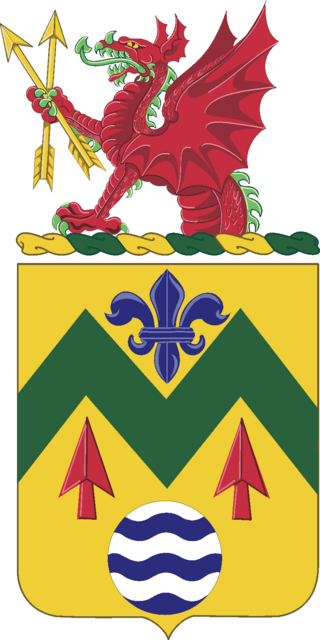
The 528th Support Battalion is a battalion of the United States Army. The 528th Support Battalion's mission is to provide rapidly deployable CSS and HSS to ARSOF as directed. The 528th Support Battalion's strengths lie in its capability to support ARSOF-unique and low-density weapons and vehicles. The 528th complements [organic] 22 ARSOF CSS, HSS, and signal units. The support battalion consists of a headquarters and main support company (HMSC), three forward support companies and may receive augmentation from Theater Army. As part of Army Special Operations Command the unit, along with the 112th Signal Battalion, is tasked to provide full logistical support to Army Special Operations Forces forming along with several other units what was known as Special Operations Support Command, later reorganized as the 528th Sustainment Brigade. Brigade Troops Battalion includes a wide variety of military occupation specialists: riggers, drivers, medics, mechanics, engineers, fuelers, cooks, etc.

The 19th Special Forces Group (Airborne) (19th SFG) (A) is one of two National Guard groups of the United States Army Special Forces. 19th Group—as it is sometimes called—is designed to deploy and execute nine doctrinal missions: unconventional warfare, foreign internal defense, direct action, counter-insurgency, special reconnaissance, counter-terrorism, information operations, counterproliferation of weapon of mass destruction, and security force assistance. Headquartered in Bluffdale, Utah, with detachments in Washington, West Virginia, Ohio, Rhode Island, Colorado, California and Texas, the 19th SFG(A) shares responsibility over Southwest Asia with the 5th Special Forces Group (Airborne), and the Pacific with the 1st Special Forces Group (Airborne). Company A, 2nd Battalion is one of several National Guard units with colonial roots.

The 97th Civil Affairs Battalion (Airborne) is a civil affairs battalion of the 95th Civil Affairs Brigade (Airborne) based at Fort Bragg, North Carolina. It is a member of the only active duty Special Operations Civil Affairs unit in the United States Department of Defense. The concept for a Civil Affairs brigade had been under consideration for years, but was finally approved as a result of the 2006 Quadrennial Defense Review.

The United States Army has used military berets as headgear with various uniforms beginning in World War II. Since June 14, 2001, a black beret is worn by all U.S. Army troops unless the soldier is approved to wear a different distinctive beret. A maroon beret has been adopted as official headdress by the Airborne forces, a tan beret by the 75th Ranger Regiment, a brown beret by the Security Force Assistance Brigades, and a green beret by the Special Forces.

The U.S. Army Special Forces traces its roots as the Army's premier proponent of unconventional warfare from purpose-formed special operations units like the Alamo Scouts, Philippine guerrillas, First Special Service Force, and the Operational Groups (OGs) of the Office of Strategic Services. Although the OSS was not an Army organization, many Army personnel were assigned to the OSS and later used their experiences to influence the forming of Special Forces.

The 525th Expeditionary Military Intelligence Brigade (Expeditionary) is a unit of the United States Army specializing in the acquisition and analysis of information with potential military value. On 28 October 2014, the unit was reflagged from the "525th Battlefield Surveillance Brigade" to an expeditionary military intelligence brigade, the first of its kind.

The United States Army Special Operations Aviation Command (USASOAC) provides command and control, executive oversight, and resourcing of U.S. Army Special Operations Command (USASOC) aviation assets and units in support of national security objectives. USASOAC is responsible for service and component interface; training, doctrine, and proponency for Army Special Operations Aviation (SOA); system integration and fleet modernization; aviation resource management; material readiness; program management; and ASCC oversight. USASOAC was established 25 March 2011 consisting of 135 headquarters soldiers and subordinate units totaling more than 3,300 personnel, include the 160th Special Operations Aviation Regiment (Airborne), (160th SOAR (A)) which features 4 Aviation Battalions, the USASOC Flight Company, the Special Operations Aviation Training Battalion, the Systems Integration Management Office, and the Technology Application Projects Office. The first commander of USASOAC was Brig Gen. Kevin Mangum.
